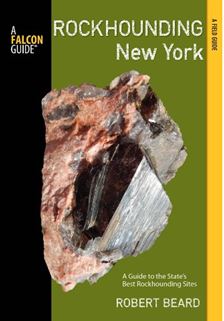
The compositional variety, the range of color variation, and the diverse origin of tourmalines has led to several books on the subject. Some are very technical, either mineralogically or technically, but for me one stands out for the mineral collector. The Collector’s Guide to the Tourmaline Group by Robert J. Lauf (Schiffer Publishing) combines adequate detail on tourmaline chemistry and taxonomy with a pictorial account of all the recognized tourmaline species. Lauf does all this at a level that is not daunting for the non-geologist. The price is right also, $19.99 list for the oversize softcover book, and I found it for a few dollars less online.
Incidentally, this is one of a series of books published by Schiffer on various minerals or mineral groups. All are informative and affordable and well illustrated.

An article I wrote for the April 2014 WCGMC News
The Rochester shale comprises the upper 85’-90’ of the Middle Silurian Clinton Group in upstate New York and southern Ontario. The upper two-thirds of the unit contain numerous grey limestone beds, which can be sufficiently resistant to form outcrops, but which are poor in fossil content. The lower 20’ of the Rochester shale is notoriously susceptible to erosion such that outcrop exposure is rare. Unfortunately, it is this rapidly weathering unit at the base that contains the abundant fossil assemblage (specifically trilobites) for which the formation is famous. The best visible exposure of the full Rochester shale section is in the gorge walls of High Falls on the Genesee River. However, this section is agonizingly unapproachable for fossil collection, particularly so the lower 10-20’ of section best known for fossil diversity and abundance.
Over 200 invertebrate fossil species have been identified from the Rochester shale including corals, brachiopods, bivalves, gastropods, cephalopods and crinoids. But, it is the spectacularly preserved trilobites that have attracted collectors to the Rochester shale since James Hall first detailed their occurrence in the 1840’s. The diverse fauna combined with the fine grained shale beds and thin limestone units indicate that the Rochester shale was deposited in warm, well oxygenated marine waters of intermediate depth. But where does one find outcrop to search for fossils?
Continue reading Rochester Shale – Silurian Fossils →

This is a two part post reporting the results of two Rochester Philatelic Association meetings in early 2014.
Part 1. January 9th, 2014 meeting, text from Hinges and Tongs Jan-March 2014 issue
It is a New Year and the Rochester Philatelic Association ushered it in on January 9th by learning a bit about the art of exhibiting. Past president, and ROPEX chairman Tom Fortunato described the basics of exhibiting to a audience of 28 members.
Continue reading Learning to Exhibit →

Rockhounding New York: A Field Guide to the State’s Best Rockhounding Sites by Robert Beard Falcon Guides (2014)
With this informative guide, you can explore the mineral-rich state of New York, from the beaches to the mountains. The book describes the states’ best rockhounding sites and covers popular and commercial sites as well as numerous little-known areas. Although the technical and mineralogical data on the 98 sites is a bit brief, this handy guide does include maps and directions to each site and enough rockhounding information to at least prepare you for your visit.
Brief sections in the front of the book review the state’s bedrock geology and natural resources and there is also a short section on basic rockhounding.
Continue reading Rockhounding New York: A Book Review →
Article I wrote for the March, 2014 WCGMC News
If Time is Relative, Geologic Time is Exponentially Relative
The geologic time scale is a difficult concept for humans to appreciate. We live less than 100 years, the Vikings came to America 1000 years ago, our current calendar just passed the 2000 year mark, and Stonehenge dates almost 5000 years old. That, we say, was a long time ago. But these are mere seconds on a geologic clock. Even the final Ice Age advance that generated upstate New York’s topography and fertile soil ended a mere 12,500 years ago.
Now think about this. Dinosaurs roamed and dominated much of the planet for the entire Mesozoic Era. For over 160 million years (MY) they lived, and died until going extinct about 65 million years ago. By comparison, humans have been inhabitants for just under one million years. And all but the last 6000 years or so of that is referred to as the Stone Age, the period before metal was worked and likely before crops were cultivated.
Continue reading Geologic Time →
Retired, collecting minerals and stamps, growing flowers and vegetables, and when the spirit moves, toying with technology



